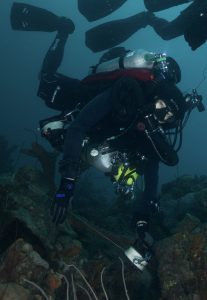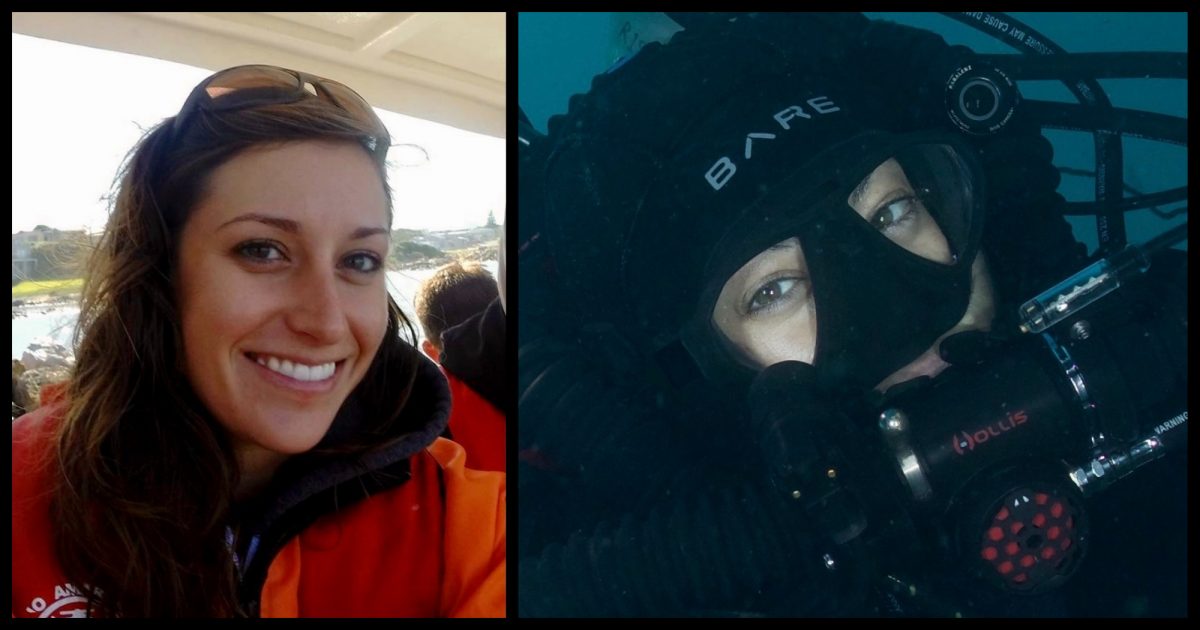The water’s cold and the visibility’s been limited, but that hasn’t stopped Allison Shafer from diving lately. Just the other day, in fact, her and a colleague were helping out a sister organization with some of their research.
Diving a territory that spans the Sonoma and Monterey coasts, Shafer has been surveying California’s rocky reefs and kelp forests often over past months on behalf of Reef Check California. “There are a lot of urchin barons right now,” she recalls from a recent dive. “Invertebrates, fish, kelp, substrate, that kind of thing.”
Most of her field duties as a Dive Officer at the California Academy of Sciences (Cal Academy) are currently suspended, so she, along with her fellow Dive Officer, Marina Bozinovich, have been volunteering for the environmental org.
“Their Citizen Science program usually relies on the general public coming out for dives,” Shafer explains. “But with Covid, they weren’t able to retrain anybody. So, Marina and I have picked up the slack.”
For her day job, Shafer’s part of Cal Academy’s groundbreaking scientific dive team team that’s on the cutting edge of global mesophotic research. As a smart, hardworking dive scientist, she’s one of the leading women in her field.
Thus, we wanted to sit down with Shafer and learn more about her career path, training objectives and recent diving exploits.
8 Questions For Allison Shafer
How has Covid affected your research?
Well, everything’s been kinda put on hold as far as fieldwork goes. Between the two teams [at Cal Academy], there’s usually four or five deep fish expeditions and two to three deep coral expeditions going on.
As for our scientists, some of them remained in San Francisco and some of them went home to New Zealand, Brazil and other places. So everyone is kind of hunkered down working on analysis right now, making the best of it, but no one’s out diving.
Even our aquarium program: all training dives have been put on hold, all collection dives have been put on hold.
Really, the only thing that we’ve been able to do since this all started was get out and volunteer for Reef Check, which is amazing! It’s not our research, but we’re still contributing to science that benefits the local ecosystems around here.
In our interview with your colleague, Marina Bozinovich, she mentioned a mesophotic project you’re doing with Monterey Bay Aquarium. Is that also on hold?
Yes, that’s also been put on hold. Every aquarium field diving program has been essentially suspended. But in the future, we’re looking forward to teaming up with our local affiliates to do some deep collections, definitely for Monterey Bay, but also Cal Academy’s aquarium, too.

How’d you start diving?
I grew up with fairly easy access to the ocean in San Jose. I always wanted to learn to dive. But it wasn’t until I was at UC Berkeley studying marine science that I finally saved up enough to take the PADI Open Water course.
Within a year of recreational diving along the California coast, I took a scientific diving class for my major in college. Totally hooked. So after graduating with my B.S. I moved to Tanzania to become a scientific diver for a coral reef monitoring project. I did my Dive Master course there and also worked in a local dive shop, too!
Nice! So how’d you get from Tanzania to Cal Academy?
Cal Academy was a very happy accident for me. I was all set to go start my Masters degree in marine biology. Over the summer prior to that I started volunteering for, of all things, a geology department that was doing a marine paleontology project.
I volunteered there for a couple months and ended up getting hired. It was such a cool job that I had to put my grad school plans on temporary hold to get some more experience.
They brought me in as the same position that Marina entered in as the dive ops intern. Then, after about six months, they hired me full time. Shortly after that, I trained to become an instructor and a service technician for all of the various equipment we have.
Then came the mixed gas PRISM 2 diver cert in order to support all of our scientists doing mesophotic work here.
What’s next?
Next up on my list, my priority at least—we’ll see what my boss says—is to become a PRISM 2 instructor. It would be cool to offer that as a perk of coming to work at Cal Academy for scientists and it will help expand their mesophotic research program.
Historically, diving has been a pretty male-dominated arena. What’s it been like coming up as a woman in the dive industry?
I guess I was pretty lucky. I started my technical training with an all-female cohort, full of bright, amazing female scientist divers. We have a mentor, Mauritius Bell, our boss and our instructor, who’s very in tune with this struggle of women in the male-dominated world of tech diving. He supports getting more women involved.
I’ve worked on the recreational side of diving, as well, and have been very much exposed to some of the bad advertising out there that use women in bikinis to sell regulators.

Also, when I started my non-scientific dive training at Berkeley most of my class was women, too. Really smart, interested people who weren’t afraid to get cold. Overall, I’m encouraged. The number of marine biology majors is heavily majority women now. Hopefully that trend continues into the future.
Still, the stats indicate that the majority of upper-level faculty positions still disproportionately go to men. I’m hopeful that the shift to women taking more STEM will eventually evolve into greater numbers of female scientific technical divers.
For now, though, it’s definitely still a challenge. I’m often the only female on board the dive boats when we go out on expeditions. We do have some female postdocs coming in who are interested in mesophotic research. But currently, when we travel around the world, a lot of the dive crews are really unaccustomed to seeing female technical divers.
We get a lot of: “Can I help you carry that? Need help getting off the boat?” That sort of thing.
But it’s great to change those misconceptions. To show that women are capable divers. In the future, I’m hoping for more representation, just in general. It gets more young women into tech diving.
On that note, how do you think we can get more young women into tech diving?
Like I said, it’s going to be a gradual change. Especially with all of the dive manufacturers getting on board with the fact that women are getting more into diving.
But the lack of women-specific equipment makes it hard to find stuff for people with smaller frames. So we often compromise with gear that’s designed for men. Uncomfortable sizing—and don’t get me started on pink!
It might be a smaller market right now, but the more that manufacturers cater to women, advertise for women and create for women, I think that’ll help things along as well.
Why is equal representation in tech diving important?
Speaking from my own point of view, I’m lucky. I have a college degree and early on I was exposed to successful women. That’s not the case everywhere in the world. There’s probably still a misconception about diving, especially tech diving, that it’s dangerous and not suited for a woman. That kind of thing.
Clearly the sport is safer and more inclusive, and that’s an amazing trend. But the more that people—women especially—see equal representation, that’s a role model that opens up their mind to thinking: “Hey, I could do that.”






 Canada
Canada Other countries
Other countries

